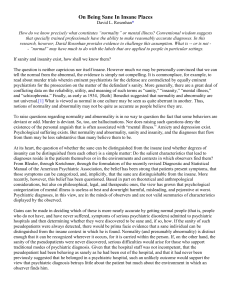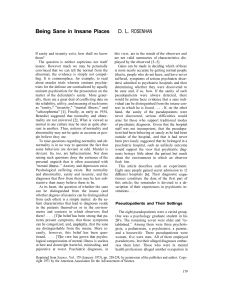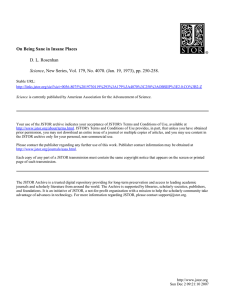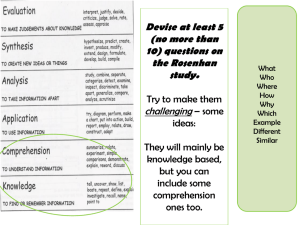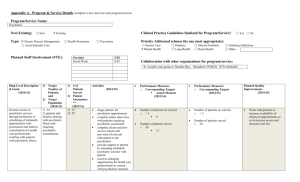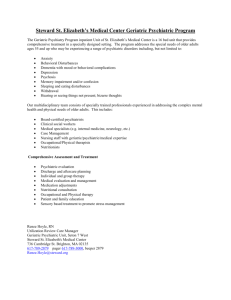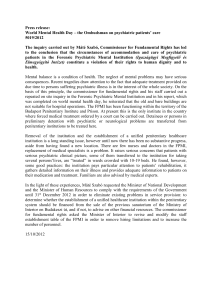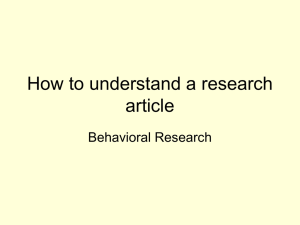Rosenhan full study
advertisement
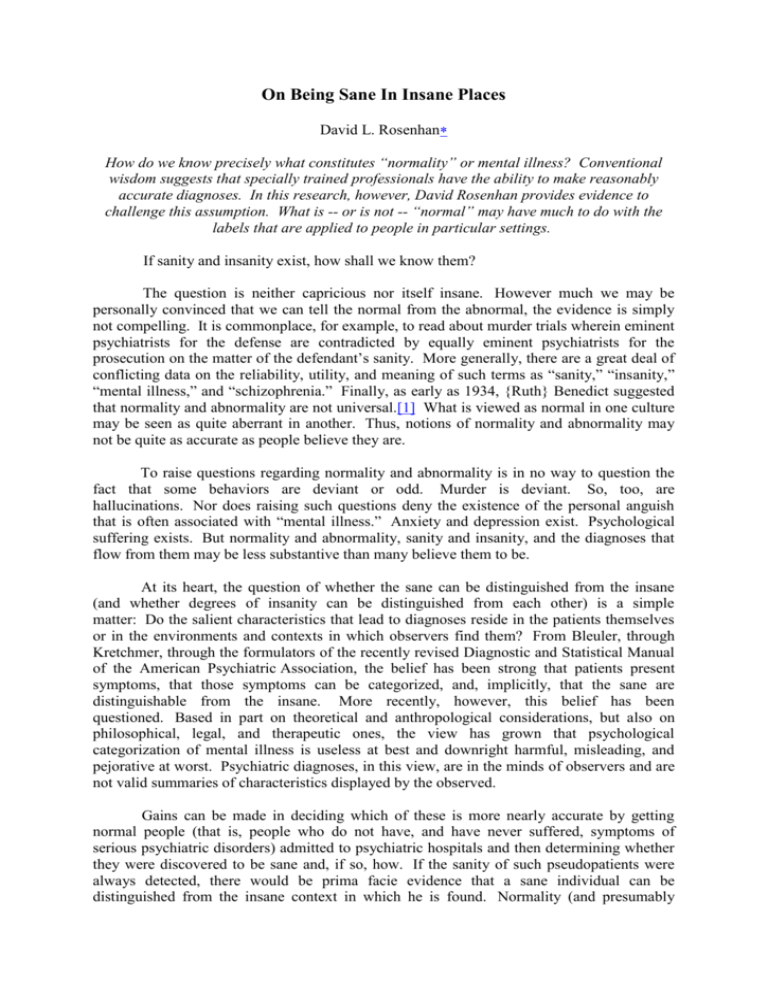
On Being Sane In Insane Places
David L. Rosenhan
How do we know precisely what constitutes “normality” or mental illness? Conventional
wisdom suggests that specially trained professionals have the ability to make reasonably
accurate diagnoses. In this research, however, David Rosenhan provides evidence to
challenge this assumption. What is -- or is not -- “normal” may have much to do with the
labels that are applied to people in particular settings.
If sanity and insanity exist, how shall we know them?
The question is neither capricious nor itself insane. However much we may be
personally convinced that we can tell the normal from the abnormal, the evidence is simply
not compelling. It is commonplace, for example, to read about murder trials wherein eminent
psychiatrists for the defense are contradicted by equally eminent psychiatrists for the
prosecution on the matter of the defendant’s sanity. More generally, there are a great deal of
conflicting data on the reliability, utility, and meaning of such terms as “sanity,” “insanity,”
“mental illness,” and “schizophrenia.” Finally, as early as 1934, {Ruth} Benedict suggested
that normality and abnormality are not universal.[1] What is viewed as normal in one culture
may be seen as quite aberrant in another. Thus, notions of normality and abnormality may
not be quite as accurate as people believe they are.
To raise questions regarding normality and abnormality is in no way to question the
fact that some behaviors are deviant or odd. Murder is deviant. So, too, are
hallucinations. Nor does raising such questions deny the existence of the personal anguish
that is often associated with “mental illness.” Anxiety and depression exist. Psychological
suffering exists. But normality and abnormality, sanity and insanity, and the diagnoses that
flow from them may be less substantive than many believe them to be.
At its heart, the question of whether the sane can be distinguished from the insane
(and whether degrees of insanity can be distinguished from each other) is a simple
matter: Do the salient characteristics that lead to diagnoses reside in the patients themselves
or in the environments and contexts in which observers find them? From Bleuler, through
Kretchmer, through the formulators of the recently revised Diagnostic and Statistical Manual
of the American Psychiatric Association, the belief has been strong that patients present
symptoms, that those symptoms can be categorized, and, implicitly, that the sane are
distinguishable from the insane. More recently, however, this belief has been
questioned. Based in part on theoretical and anthropological considerations, but also on
philosophical, legal, and therapeutic ones, the view has grown that psychological
categorization of mental illness is useless at best and downright harmful, misleading, and
pejorative at worst. Psychiatric diagnoses, in this view, are in the minds of observers and are
not valid summaries of characteristics displayed by the observed.
Gains can be made in deciding which of these is more nearly accurate by getting
normal people (that is, people who do not have, and have never suffered, symptoms of
serious psychiatric disorders) admitted to psychiatric hospitals and then determining whether
they were discovered to be sane and, if so, how. If the sanity of such pseudopatients were
always detected, there would be prima facie evidence that a sane individual can be
distinguished from the insane context in which he is found. Normality (and presumably
abnormality) is distinct enough that it can be recognized wherever it occurs, for it is carried
within the person. If, on the other hand, the sanity of the pseudopatients were never
discovered, serious difficulties would arise for those who support traditional modes of
psychiatric diagnosis. Given that the hospital staff was not incompetent, that the
pseudopatient had been behaving as sanely as he had been out of the hospital, and that it had
never been previously suggested that he belonged in a psychiatric hospital, such an unlikely
outcome would support the view that psychiatric diagnosis betrays little about the patient but
much about the environment in which an observer finds him.
This article describes such an experiment. Eight sane people gained secret admission
to 12 different hospitals. Their diagnostic experiences constitute the data of the first part of
this article; the remainder is devoted to a description of their experiences in psychiatric
institutions. Too few psychiatrists and psychologists, even those who have worked in such
hospitals, know what the experience is like. They rarely talk about it with former patients,
perhaps because they distrust information coming from the previously insane. Those who
have worked in psychiatric hospitals are likely to have adapted so thoroughly to the settings
that they are insensitive to the impact of that experience. And while there have been
occasional reports of researchers who submitted themselves to psychiatric hospitalization,
these researchers have commonly remained in the hospitals for short periods of time, often
with the knowledge of the hospital staff. It is difficult to know the extent to which they were
treated like patients or like research colleagues. Nevertheless, their reports about the inside
of the psychiatric hospital have been valuable. This article extends those efforts.
PSEUDOPATIENTS AND THEIR SETTINGS
The eight pseudopatients were a varied group. One was a psychology graduate student
in his 20’s. The remaining seven were older and “established.” Among them were three
psychologists, a pediatrician, a psychiatrist, a painter, and a housewife. Three pseudopatients
were women, five were men. All of them employed pseudonyms, lest their alleged diagnoses
embarrass them later. Those who were in mental health professions alleged another
occupation in order to avoid the special attentions that might be accorded by staff, as a matter
of courtesy or caution, to ailing colleagues.[2] With the exception myself (I was the first
pseudopatient and my presence was known to the hospital administration and chief
psychologist and, so far as I can tell, to them alone), the presence of pseudopatients and the
nature of the research program was not known to the hospital staffs.[3]
The settings are similarly varied. In order to generalize the findings, admission into a
variety of hospitals was sought. The 12 hospitals in the sample were located in five different
states on the East and West coasts. Some were old and shabby, some were quite new. Some
had good staff-patient ratios, others were quite understaffed. Only one was a strict private
hospital. All of the others were supported by state or federal funds or, in one instance, by
university funds.
After calling the hospital for an appointment, the pseudopatient arrived at the
admissions office complaining that he had been hearing voices. Asked what the voices said,
he replied that they were often unclear, but as far as he could tell they said
“empty,” “hollow,” and “thud.” The voices were unfamiliar and were of the same sex as the
pseudopatient. The choice of these symptoms was occasioned by their apparent similarity to
existential symptoms. Such symptoms are alleged to arise from painful concerns about the
perceived meaninglessness of one’s life. It is as if the hallucinating person were saying, “My
life is empty and hollow.” The choice of these symptoms was also determined by the
absence of a single report of existential psychoses in the literature.
Beyond alleging the symptoms and falsifying name, vocation, and employment, no
further alterations of person, history, or circumstances were made. The significant events of
the pseudopatient’s life history were presented as they had actually occurred. Relationships
with parents and siblings, with spouse and children, with people at work and in school,
consistent with the aforementioned exceptions, were described as they were or had
been. Frustrations and upsets were described along with joys and satisfactions. These facts
are important to remember. If anything, they strongly biased the subsequent results in favor
of detecting insanity, since none of their histories or current behaviors were seriously
pathological in any way.
Immediately upon admission to the psychiatric ward, the pseudopatient ceased
simulating any symptoms of abnormality. In some cases, there was a brief period of mild
nervousness and anxiety, since none of the pseudopatients really believed that they would be
admitted so easily. Indeed, their shared fear was that they would be immediately exposed as
frauds and greatly embarrassed. Moreover, many of them had never visited a psychiatric
ward; even those who had, nevertheless had some genuine fears about what might happen to
them. Their nervousness, then, was quite appropriate to the novelty of the hospital setting,
and it abated rapidly.
Apart from that short-lived nervousness, the pseudopatient behaved on the ward as he
“normally” behaved. The pseudopatient spoke to patients and staff as he might
ordinarily. Because there is uncommonly little to do on a psychiatric ward, he attempted to
engage others in conversation. When asked by staff how he was feeling, he indicated that he
was fine, that he no longer experienced symptoms. He responded to instructions from
attendants, to calls for medication (which was not swallowed), and to dining-hall
instructions. Beyond such activities as were available to him on the admissions ward, he
spent his time writing down his observations about the ward, its patients, and the
staff. Initially these notes were written “secretly,” but as it soon became clear that no one
much cared, they were subsequently written on standard tablets of paper in such public places
as the dayroom. No secret was made of these activities.
The pseudopatient, very much as a true psychiatric patient, entered a hospital with no
foreknowledge of when he would be discharged. Each was told that he would have to get out
by his own devices, essentially by convincing the staff that he was sane. The psychological
stresses associated with hospitalization were considerable, and all but one of the
pseudopatients desired to be discharged almost immediately after being admitted. They were,
therefore, motivated not only to behave sanely, but to be paragons of cooperation. That their
behavior was in no way disruptive is confirmed by nursing reports, which have been obtained
on most of the patients. These reports uniformly indicate that the patients were “friendly,”
“cooperative,” and “exhibited no abnormal indications.”
THE NORMAL ARE NOT DETECTABLY SANE
Despite their public “show” of sanity, the pseudopatients were never detected. Admitted,
except in one case, with a diagnosis of schizophrenia,[4] each was discharged with a
diagnosis of schizophrenia “in remission.” The label “in remission” should in no way be
dismissed as a formality, for at no time during any hospitalization had any question been
raised about any pseudopatient’s simulation. Nor are there any indications in the hospital
records that the pseudopatient’s status was suspect. Rather, the evidence is strong that, once
labeled schizophrenic, the pseudopatient was stuck with that label. If the pseudopatient was
to be discharged, he must naturally be “in remission”; but he was not sane, nor, in the
institution’s view, had he ever been sane.
The uniform failure to recognize sanity cannot be attributed to the quality of the
hospitals, for, although there were considerable variations among them, several are
considered excellent. Nor can it be alleged that there was simply not enough time to observe
the pseudopatients. Length of hospitalization ranged from 7 to 52 days, with an average of
19 days. The pseudopatients were not, in fact, carefully observed, but this failure speaks
more to traditions within psychiatric hospitals than to lack of opportunity.
Finally, it cannot be said that the failure to recognize the pseudopatients' sanity was
due to the fact that they were not behaving sanely. While there was clearly some tension
present in all of them, their daily visitors could detect no serious behavioral consequences—
nor, indeed, could other patients. It was quite common for the patients to “detect” the
pseudopatient’s sanity. During the first three hospitalizations, when accurate counts were
kept, 35 of a total of 118 patients on the admissions ward voiced their suspicions, some
vigorously. “You’re not crazy. You’re a journalist, or a professor (referring to the continual
note-taking). You’re checking up on the hospital.” While most of the patients were
reassured by the pseudopatient’s insistence that he had been sick before he came in but was
fine now, some continued to believe that the pseudopatient was sane throughout his
hospitalization. The fact that the patients often recognized normality when staff did not
raises important questions.
Failure to detect sanity during the course of hospitalization may be due to the fact that
physicians operate with a strong bias toward what statisticians call the Type 2 error. This is
to say that physicians are more inclined to call a healthy person sick (a false positive, Type 2)
than a sick person healthy (a false negative, Type 1). The reasons for this are not hard to
find: it is clearly more dangerous to misdiagnose illness than health. Better to err on the side
of caution, to suspect illness even among the healthy.
But what holds for medicine does not hold equally well for psychiatry. Medical
illnesses, while unfortunate, are not commonly pejorative. Psychiatric diagnoses, on the
contrary, carry with them personal, legal, and social stigmas. It was therefore important to
see whether the tendency toward diagnosing the sane insane could be reversed. The
following experiment was arranged at a research and teaching hospital whose staff had heard
these findings but doubted that such an error could occur in their hospital. The staff was
informed that at some time during the following three months, one or more pseudopatients
would attempt to be admitted into the psychiatric hospital. Each staff member was asked to
rate each patient who presented himself at admissions or on the ward according to the
likelihood that the patient was a pseudopatient. A 10-point scale was used, with a 1 and 2
reflecting high confidence that the patient was a pseudopatient.
Judgments were obtained on 193 patients who were admitted for psychiatric
treatment. All staff who had had sustained contact with or primary responsibility for the
patient – attendants, nurses, psychiatrists, physicians, and psychologists – were asked to make
judgments. Forty-one patients were alleged, with high confidence, to be pseudopatients by at
least one member of the staff. Twenty-three were considered suspect by at least one
psychiatrist. Nineteen were suspected by one psychiatrist and one other staff
member. Actually, no genuine pseudopatient (at least from my group) presented himself
during this period.
The experiment is instructive. It indicates that the tendency to designate sane people
as insane can be reversed when the stakes (in this case, prestige and diagnostic acumen) are
high. But what can be said of the 19 people who were suspected of being “sane” by one
psychiatrist and another staff member? Were these people truly "sane" or was it rather the
case that in the course of avoiding the Type 2 error the staff tended to make more errors of
the first sort – calling the crazy “sane”? There is no way of knowing. But one thing is
certain: any diagnostic process that lends itself too readily to massive errors of this sort
cannot be a very reliable one.
THE STICKINESS OF PSYCHODIAGNOSTIC LABELS
Beyond the tendency to call the healthy sick – a tendency that accounts better for
diagnostic behavior on admission than it does for such behavior after a lengthy period of
exposure – the data speak to the massive role of labeling in psychiatric assessment. Having
once been labeled schizophrenic, there is nothing the pseudopatient can do to overcome the
tag. The tag profoundly colors others’ perceptions of him and his behavior.
From one viewpoint, these data are hardly surprising, for it has long been known that
elements are given meaning by the context in which they occur. Gestalt psychology made the
point vigorously, and Asch[5] demonstrated that there are “central” personality traits (such as
“warm” versus “cold”) which are so powerful that they markedly color the meaning of other
information in forming an impression of a given personality. “Insane,” “schizophrenic,”
“manic-depressive,” and “crazy” are probably among the most powerful of such central
traits. Once a person is designated abnormal, all of his other behaviors and characteristics are
colored by that label. Indeed, that label is so powerful that many of the pseudopatients’
normal behaviors were overlooked entirely or profoundly misinterpreted. Some examples
may clarify this issue.
Earlier, I indicated that there were no changes in the pseudopatient’s personal history
and current status beyond those of name, employment, and, where necessary,
vocation. Otherwise, a veridical description of personal history and circumstances was
offered. Those circumstances were not psychotic. How were they made consonant with the
diagnosis modified in such a way as to bring them into accord with the circumstances of the
pseudopatient’s life, as described by him?
As far as I can determine, diagnoses were in no way affected by the relative health of
the circumstances of a pseudopatient’s life. Rather, the reverse occurred: the perception of
his circumstances was shaped entirely by the diagnosis. A clear example of such translation
is found in the case of a pseudopatient who had had a close relationship with his mother but
was rather remote from his father during his early childhood. During adolescence and
beyond, however, his father became a close friend, while his relationship with his mother
cooled. His present relationship with his wife was characteristically close and warm. Apart
from occasional angry exchanges, friction was minimal. The children had rarely been
spanked. Surely there is nothing especially pathological about such a history. Indeed, many
readers may see a similar pattern in their own experiences, with no markedly deleterious
consequences. Observe, however, how such a history was translated in the
psychopathological context, this from the case summary prepared after the patient was
discharged.
This white 39-year-old male . . . manifests a long history of considerable
ambivalence in close relationships, which begins in early childhood. A warm
relationship with his mother cools during his adolescence. A distant
relationship with his father is described as becoming very intense. Affective
stability is absent. His attempts to control emotionality with his wife and
children are punctuated by angry outbursts and, in the case of the children,
spankings. And while he says that he has several good friends, one senses
considerable ambivalence embedded in those relationships also . . .
The facts of the case were unintentionally distorted by the staff to achieve
consistency with a popular theory of the dynamics of a schizophrenic
reaction. Nothing of an ambivalent nature had been described in relations with
parents, spouse, or friends. To the extent that ambivalence could be inferred, it was
probably not greater than is found in all human’s relationships. It is true the
pseudopatient’s relationships with his parents changed over time, but in the ordinary
context that would hardly be remarkable – indeed, it might very well be
expected. Clearly, the meaning ascribed to his verbalizations (that is, ambivalence,
affective instability) was determined by the diagnosis: schizophrenia. An entirely
different meaning would have been ascribed if it were known that the man was
“normal.”
All pseudopatients took extensive notes publicly. Under ordinary circumstances, such
behavior would have raised questions in the minds of observers, as, in fact, it did among
patients. Indeed, it seemed so certain that the notes would elicit suspicion that elaborate
precautions were taken to remove them from the ward each day. But the precautions proved
needless. The closest any staff member came to questioning those notes occurred when one
pseudopatient asked his physician what kind of medication he was receiving and began to
write down the response. “You needn’t write it,” he was told gently. “If you have trouble
remembering, just ask me again.”
If no questions were asked of the pseudopatients, how was their writing
interpreted? Nursing records for three patients indicate that the writing was seen as an aspect
of their pathological behavior. “Patient engaged in writing behavior” was the daily nursing
comment on one of the pseudopatients who was never questioned about his writing. Given
that the patient is in the hospital, he must be psychologically disturbed. And given that he is
disturbed, continuous writing must be behavioral manifestation of that disturbance, perhaps a
subset of the compulsive behaviors that are sometimes correlated with schizophrenia.
One tacit characteristic of psychiatric diagnosis is that it locates the sources of
aberration within the individual and only rarely within the complex of stimuli that surrounds
him. Consequently, behaviors that are stimulated by the environment are commonly
misattributed to the patient’s disorder. For example, one kindly nurse found a pseudopatient
pacing the long hospital corridors. “Nervous, Mr. X?” she asked. “No, bored,” he said.
The notes kept by pseudopatients are full of patient behaviors that were misinterpreted
by well-intentioned staff. Often enough, a patient would go “berserk” because he had,
wittingly or unwittingly, been mistreated by, say, an attendant. A nurse coming upon the
scene would rarely inquire even cursorily into the environmental stimuli of the patient’s
behavior. Rather, she assumed that his upset derived from his pathology, not from his present
interactions with other staff members. Occasionally, the staff might assume that the patient’s
family (especially when they had recently visited) or other patients had stimulated the
outburst. But never were the staff found to assume that one of themselves or the structure of
the hospital had anything to do with a patient’s behavior. One psychiatrist pointed to a group
of patients who were sitting outside the cafeteria entrance half an hour before lunchtime. To
a group of young residents he indicated that such behavior was characteristic of the oralacquisitive nature of the syndrome. It seemed not to occur to him that there were very few
things to anticipate in a psychiatric hospital besides eating.
A psychiatric label has a life and an influence of its own. Once the impression has
been formed that the patient is schizophrenic, the expectation is that he will continue to be
schizophrenic. When a sufficient amount of time has passed, during which the patient has
done nothing bizarre, he is considered to be in remission and available for discharge. But the
label endures beyond discharge, with the unconfirmed expectation that he will behave as a
schizophrenic again. Such labels, conferred by mental health professionals, are as influential
on the patient as they are on his relatives and friends, and it should not surprise anyone that
the diagnosis acts on all of them as a self-fulfilling prophecy. Eventually, the patient himself
accepts the diagnosis, with all of its surplus meanings and expectations, and behaves
accordingly.
The inferences to be made from these matters are quite simple. Much as Zigler and
Phillips have demonstrated that there is enormous overlap in the symptoms presented by
patients who have been variously diagnosed,[6] so there is enormous overlap in the behaviors
of the sane and the insane. The sane are not “sane” all of the time. We lose our tempers “for
no good reason.” We are occasionally depressed or anxious, again for no good reason. And
we may find it difficult to get along with one or another person – again for no reason that we
can specify. Similarly, the insane are not always insane. Indeed, it was the impression of the
pseudopatients while living with them that they were sane for long periods of time – that the
bizarre behaviors upon which their diagnoses were allegedly predicated constituted only a
small fraction of their total behavior. If it makes no sense to label ourselves permanently
depressed on the basis of an occasional depression, then it takes better evidence than is
presently available to label all patients insane or schizophrenic on the basis of bizarre
behaviors or cognitions. It seems more useful, as Mischel[7] has pointed out, to limit our
discussions to behaviors the stimuli that provoke them, and their correlates.
It is not known why powerful impressions of personality traits, such as “crazy” or
“insane,” arise. Conceivably, when the origins of and stimuli that give rise to a behavior are
remote or unknown, or when the behavior strikes us as immutable, trait labels regarding the
behavior arise. When, on the other hand, the origins and stimuli are known and available,
discourse is limited to the behavior itself. Thus, I may hallucinate because I am sleeping, or I
may hallucinate because I have ingested a peculiar drug. These are termed sleep-induced
hallucinations, or dreams, and drug-induced hallucinations, respectively. But when the
stimuli to my hallucinations are unknown, that is called craziness, or schizophrenia –as if that
inference were somehow as illuminating as the others.
THE EXPERIENCE OF PSYCHIATRIC HOSPITALIZATION
The term “mental illness” is of recent origin. It was coined by people who were humane in
their inclinations and who wanted very much to raise the station of (and the public’s
sympathies toward) the psychologically disturbed from that of witches and “crazies” to one
that was akin to the physically ill. And they were at least partially successful, for the
treatment of the mentally ill has improved considerably over the years. But while treatment
has improved, it is doubtful that people really regard the mentally ill in the same way that
they view the physically ill. A broken leg is something one recovers from, but mental illness
allegedly endures forever. A broken leg does not threaten the observer, but a crazy
schizophrenic? There is by now a host of evidence that attitudes toward the mentally ill are
characterized by fear, hostility, aloofness, suspicion, and dread. The mentally ill are society’s
lepers.
That such attitudes infect the general population is perhaps not surprising, only
upsetting. But that they affect the professionals – attendants, nurses, physicians,
psychologists and social workers – who treat and deal with the mentally ill is more
disconcerting, both because such attitudes are self-evidently pernicious and because they are
unwitting. Most mental health professionals would insist that they are sympathetic toward
the mentally ill, that they are neither avoidant nor hostile. But it is more likely that an
exquisite ambivalence characterizes their relations with psychiatric patients, such that their
avowed impulses are only part of their entire attitude. Negative attitudes are there too and
can easily be detected. Such attitudes should not surprise us. They are the natural offspring
of the labels patients wear and the places in which they are found.
Consider the structure of the typical psychiatric hospital. Staff and patients are
strictly segregated. Staff have their own living space, including their dining facilities,
bathrooms, and assembly places. The glassed quarters that contain the professional staff,
which the pseudopatients came to call “the cage,” sit out on every dayroom. The staff
emerge primarily for care-taking purposes – to give medication, to conduct therapy or group
meeting, to instruct or reprimand a patient. Otherwise, staff keep to themselves, almost as if
the disorder that afflicts their charges is somehow catching.
So much is patient-staff segregation the rule that, for four public hospitals in which an
attempt was made to measure the degree to which staff and patients mingle, it was necessary
to use “time out of the staff cage” as the operational measure. While it was not the case that
all time spent out of the cage was spent mingling with patients (attendants, for example,
would occasionally emerge to watch television in the dayroom), it was the only way in which
one could gather reliable data on time for measuring.
The average amount of time spent by attendants outside of the cage was 11.3 percent
(range, 3 to 52 percent). This figure does not represent only time spent mingling with
patients, but also includes time spent on such chores as folding laundry, supervising patients
while they shave, directing ward cleanup, and sending patients to off-ward activities. It was
the relatively rare attendant who spent time talking with patients or playing games with
them. It proved impossible to obtain a “percent mingling time” for nurses, since the amount
of time they spent out of the cage was too brief. Rather, we counted instances of emergence
from the cage. On the average, daytime nurses emerged from the cage 11.5 times per shift,
including instances when they left the ward entirely (range, 4 to 39 times). Later afternoon
and night nurses were even less available, emerging on the average 9.4 times per shift (range,
4 to 41 times). Data on early morning nurses, who arrived usually after midnight and
departed at 8 a.m., are not available because patients were asleep during most of this period.
Physicians, especially psychiatrists, were even less available. They were rarely seen
on the wards. Quite commonly, they would be seen only when they arrived and departed,
with the remaining time being spend in their offices or in the cage. On the average,
physicians emerged on the ward 6.7 times per day (range, 1 to 17 times). It proved difficult
to make an accurate estimate in this regard, since physicians often maintained hours that
allowed them to come and go at different times.
The hierarchical organization of the psychiatric hospital has been commented on
before, but the latent meaning of that kind of organization is worth noting again. Those with
the most power have the least to do with patients, and those with the least power are the most
involved with them. Recall, however, that the acquisition of role-appropriate behaviors
occurs mainly through the observation of others, with the most powerful having the most
influence. Consequently, it is understandable that attendants not only spend more time with
patients than do any other members of the staff – that is required by their station in the
hierarchy – but, also, insofar as they learn from their superior’s behavior, spend as little time
with patients as they can. Attendants are seen mainly in the cage, which is where the
models, the action, and the power are.
I turn now to a different set of studies, these dealing with staff response to patientinitiated contact. It has long been known that the amount of time a person spends with you
can be an index of your significance to him. If he initiates and maintains eye contact, there is
reason to believe that he is considering your requests and needs. If he pauses to chat or
actually stops and talks, there is added reason to infer that he is individuating you. In four
hospitals, the pseudopatients approached the staff member with a request which took the
following form: “Pardon me, Mr. [or Dr. or Mrs.] X, could you tell me when I will be
eligible for grounds privileges?” (or “ . . . when I will be presented at the staff meeting?” or
“. . . when I am likely to be discharged?”). While the content of the question varied
according to the appropriateness of the target and the pseudopatient’s (apparent) current
needs the form was always a courteous and relevant request for information. Care was taken
never to approach a particular member of the staff more than once a day, lest the staff
member become suspicious or irritated . . .[R]emember that the behavior of the
pseudopatients was neither bizarre nor disruptive. One could indeed engage in good
conversation with them.
. . . Minor differences between these four institutions were overwhelmed by the
degree to which staff avoided continuing contacts that patients had initiated. By far, their
most common response consisted of either a brief response to the question, offered while they
were “on the move” and with head averted, or no response at all. The encounter frequently
took the following bizarre form: (pseudopatient) “Pardon me, Dr. X. Could you tell me
when I am eligible for grounds privileges?” (physician) “Good morning, Dave. How are
you today? (Moves off without waiting for a response.) . . .
POWERLESSNESS AND DEPERSONALIZATION
Eye contact and verbal contact reflect concern and individuation; their absence, avoidance
and depersonalization. The data I have presented do not do justice to the rich daily
encounters that grew up around matters of depersonalization and avoidance. I have records
of patients who were beaten by staff for the sin of having initiated verbal contact. During my
own experience, for example, one patient was beaten in the presence of other patients for
having approached an attendant and told him, “I like you.” Occasionally, punishment meted
out to patients for misdemeanors seemed so excessive that it could not be justified by the
most rational interpretations of psychiatric cannon. Nevertheless, they appeared to go
unquestioned. Tempers were often short. A patient who had not heard a call for medication
would be roundly excoriated, and the morning attendants would often wake patients with,
“Come on, you m_ _ _ _ _ f _ _ _ _ _ s, out of bed!”
Neither anecdotal nor “hard” data can convey the overwhelming sense of
powerlessness which invades the individual as he is continually exposed to the
depersonalization of the psychiatric hospital. It hardly matters which psychiatric hospital –
the excellent public ones and the very plush private hospital were better than the rural and
shabby ones in this regard, but, again, the features that psychiatric hospitals had in common
overwhelmed by far their apparent differences.
Powerlessness was evident everywhere.
The patient is deprived of many of his legal rights by dint of his psychiatric
commitment. He is shorn of credibility by virtue of his psychiatric label. His freedom of
movement is restricted. He cannot initiate contact with the staff, but may only respond to
such overtures as they make. Personal privacy is minimal. Patient quarters and possessions
can be entered and examined by any staff member, for whatever reason. His personal history
and anguish is available to any staff member (often including the “grey lady” and “candy
striper” volunteer) who chooses to read his folder, regardless of their therapeutic relationship
to him. His personal hygiene and waste evacuation are often monitored. The water closets
have no doors.
At times, depersonalization reached such proportions that pseudopatients had the
sense that they were invisible, or at least unworthy of account. Upon being admitted, I and
other pseudopatients took the initial physical examinations in a semipublic room, where staff
members went about their own business as if we were not there.
On the ward, attendants delivered verbal and occasionally serious physical abuse to
patients in the presence of others (the pseudopatients) who were writing it all down. Abusive
behavior, on the other hand, terminated quite abruptly when other staff members were known
to be coming. Staff are credible witnesses. Patients are not.
A nurse unbuttoned her uniform to adjust her brassiere in the present of an entire ward
of viewing men. One did not have the sense that she was being seductive. Rather, she didn’t
notice us. A group of staff persons might point to a patient in the dayroom and discuss him
animatedly, as if he were not there.
One illuminating instance of depersonalization and invisibility occurred with regard to
medication. All told, the pseudopatients were administered nearly 2100 pills, including
Elavil, Stelazine, Compazine, and Thorazine, to name but a few. (That such a variety of
medications should have been administered to patients presenting identical symptoms is itself
worthy of note.) Only two were swallowed. The rest were either pocketed or deposited in
the toilet. The pseudopatients were not alone in this. Although I have no precise records on
how many patients rejected their medications, the pseudopatients frequently found the
medications of other patients in the toilet before they deposited their own. As long as they
were cooperative, their behavior and the pseudopatients’ own in this matter, as in other
important matters, went unnoticed throughout.
Reactions to such depersonalization among pseudopatients were intense. Although
they had come to the hospital as participant observers and were fully aware that they did not
“belong,” they nevertheless found themselves caught up in and fighting the process of
depersonalization. Some examples: a graduate student in psychology asked his wife to bring
his textbooks to the hospital so he could “catch up on his homework” – this despite the
elaborate precautions taken to conceal his professional association. The same student, who
had trained for quite some time to get into the hospital, and who had looked forward to the
experience, “remembered” some drag races that he had wanted to see on the weekend and
insisted that he be discharged by that time. Another pseudopatient attempted a romance with
a nurse. Subsequently, he informed the staff that he was applying for admission to graduate
school in psychology and was very likely to be admitted, since a graduate professor was one
of his regular hospital visitors. The same person began to engage in psychotherapy with
other patients – all of this as a way of becoming a person in an impersonal environment.
THE SOURCES OF DEPERSONALIZATION
What are the origins of depersonalization? I have already mentioned two. First are attitudes
held by all of us toward the mentally ill – including those who treat them – attitudes
characterized by fear, distrust, and horrible expectations on the one hand, and benevolent
intentions on the other. Our ambivalence leads, in this instance as in others, to avoidance.
Second, and not entirely separate, the hierarchical structure of the psychiatric hospital
facilitates depersonalization. Those who are at the top have least to do with patients, and
their behavior inspires the rest of the staff. Average daily contact with psychiatrists,
psychologists, residents, and physicians combined ranged form 3.9 to 25.1 minutes, with an
overall mean of 6.8 (six pseudopatients over a total of 129 days of hospitalization). Included
in this average are time spent in the admissions interview, ward meetings in the presence of a
senior staff member, group and individual psychotherapy contacts, case presentation
conferences and discharge meetings. Clearly, patients do not spend much time in
interpersonal contact with doctoral staff. And doctoral staff serve as models for nurses and
attendants.
There are probably other sources. Psychiatric installations are presently in serious
financial straits. Staff shortages are pervasive, and that shortens patient contact. Yet, while
financial stresses are realities, too much can be made of them. I have the impression that the
psychological forces that result in depersonalization are much stronger than the fiscal ones
and that the addition of more staff would not correspondingly improve patient care in this
regard. The incidence of staff meetings and the enormous amount of record-keeping on
patients, for example, have not been as substantially reduced as has patient contact. Priorities
exist, even during hard times. Patient contact is not a significant priority in the traditional
psychiatric hospital, and fiscal pressures do not account for this. Avoidance and
depersonalization may.
Heavy reliance upon psychotropic medication tacitly contributes to depersonalization
by convincing staff that treatment is indeed being conducted and that further patient contact
may not be necessary. Even here, however, caution needs to be exercised in understanding
the role of psychotropic drugs. If patients were powerful rather than powerless, if they were
viewed as interesting individuals rather than diagnostic entities, if they were socially
significant rather than social lepers, if their anguish truly and wholly compelled our
sympathies and concerns, would we not seek contact with them, despite the availability of
medications? Perhaps for the pleasure of it all?
THE CONSEQUENCES OF LABELING AND DEPERSONALIZATION
Whenever the ratio of what is known to what needs to be known approaches zero, we tend to
invent “knowledge” and assume that we understand more than we actually do. We seem
unable to acknowledge that we simply don’t know. The needs for diagnosis and remediation
of behavioral and emotional problems are enormous. But rather than acknowledge that we
are just embarking on understanding, we continue to label patients “schizophrenic,” “manicdepressive,” and “insane,” as if in those words we captured the essence of
understanding. The facts of the matter are that we have known for a long time that diagnoses
are often not useful or reliable, but we have nevertheless continued to use them. We now
know that we cannot distinguish sanity from insanity. It is depressing to consider how that
information will be used.
Not merely depressing, but frightening. How many people, one wonders, are sane but
not recognized as such in our psychiatric institutions? How many have been needlessly
stripped of their privileges of citizenship, from the right to vote and drive to that of handling
their own accounts? How many have feigned insanity in order to avoid the criminal
consequences of their behavior, and, conversely, how many would rather stand trial than live
interminably in a psychiatric hospital – but are wrongly thought to be mentally ill? How
many have been stigmatized by well-intentioned, but nevertheless erroneous, diagnoses? On
the last point, recall again that a “Type 2 error” in psychiatric diagnosis does not have the
same consequences it does in medical diagnosis. A diagnosis of cancer that has been found
to be in error is cause for celebration. But psychiatric diagnoses are rarely found to be in
error. The label sticks, a mark of inadequacy forever.
Finally, how many patients might be “sane” outside the psychiatric hospital but seem
insane in it – not because craziness resides in them, as it were, but because they are
responding to a bizarre setting, one that may be unique to institutions which harbor nether
people? Goffman [8] calls the process of socialization to such institutions “mortification” –
an apt metaphor that includes the processes of depersonalization that have been described
here. And while it is impossible to know whether the pseudopatients’ responses to these
processes are characteristic of all inmates – they were, after all, not real patients – it is
difficult to believe that these processes of socialization to a psychiatric hospital provide
useful attitudes or habits of response for living in the “real world.”
SUMMARY AND CONCLUSIONS
It is clear that we cannot distinguish the sane from the insane in psychiatric hospitals. The
hospital itself imposes a special environment in which the meaning of behavior can easily be
misunderstood. The consequences to patients hospitalized in such an environment – the
powerlessness, depersonalization, segregation, mortification, and self-labeling – seem
undoubtedly counter-therapeutic.
I do not, even now, understand this problem well enough to perceive
solutions. But two matters seem to have some promise. The first concerns the proliferation
of community mental health facilities, of crisis intervention centers, of the human potential
movement, and of behavior therapies that, for all of their own problems, tend to avoid
psychiatric labels, to focus on specific problems and behaviors, and to retain the individual in
a relatively non-pejorative environment. Clearly, to the extent that we refrain from sending
the distressed to insane places, our impressions of them are less likely to be distorted. (The
risk of distorted perceptions, it seems to me, is always present, since we are much more
sensitive to an individual’s behaviors and verbalizations than we are to the subtle contextual
stimuli than often promote them. At issue here is a matter of magnitude. And, as I have
shown, the magnitude of distortion is exceedingly high in the extreme context that is a
psychiatric hospital.)
The second matter that might prove promising speaks to the need to increase the
sensitivity of mental health workers and researchers to the Catch 22 position of psychiatric
patients. Simply reading materials in this area will be of help to some such workers and
researchers. For others, directly experiencing the impact of psychiatric hospitalization will be
of enormous use. Clearly, further research into the social psychology of such total
institutions will both facilitate treatment and deepen understanding.
I and the other pseudopatients in the psychiatric setting had distinctly negative
reactions. We do not pretend to describe the subjective experiences of true patients. Theirs
may be different from ours, particularly with the passage of time and the necessary process of
adaptation to one’s environment. But we can and do speak to the relatively more objective
indices of treatment within the hospital. It could be a mistake, and a very unfortunate one, to
consider that what happened to us derived from malice or stupidity on the part of the
staff. Quite the contrary, our overwhelming impression of them was of people who really
cared, who were committed and who were uncommonly intelligent. Where they failed, as
they sometimes did painfully, it would be more accurate to attribute those failures to the
environment in which they, too, found themselves than to personal callousness. Their
perceptions and behaviors were controlled by the situation, rather than being motivated by a
malicious disposition. In a more benign environment, one that was less attached to global
diagnosis, their behaviors and judgments might have been more benign and effective.
I thank W. Mischel, E. Orne, and M.S. Rosenhan for comments on an earlier draft of this manuscript.
SOURCE: David L. Rosenhan, “On Being Sane in Insane Places,” Science, Vol. 179 (Jan. 1973), 250-258.
Copyright 1973 by the American Association for the Advancement of Science.
[1] R. Benedict, J.Gen. Psychol., 10 (1934), 59.
[2] Beyond the personal difficulties that the pseudopatient is likely to experience in the hospital, there are legal and social
ones that, combined, require considerable attention before entry. For example, once admitted to a psychiatric institution, it is
difficult, if not impossible, to be discharged on short notice, state law to the contrary notwithstanding. I was not sensitive to
these difficulties at the outset of the project, nor to the personal and situational emergencies that can arise, but later a writ of
habeas corpus was prepared for each of the entering pseudopatients and an attorney was kept “on call” during every
hospitalization. I am grateful to John Kaplan and Robert Bartels for legal advice and assistance in these matters.
[3] However distasteful such concealment is, it was a necessary first step to examining these
questions. Without concealment, there would have been no way to know how valid these
experiences were; nor was there any way of knowing whether whatever detections occurred
were a tribute to the diagnostic acumen of the hospital’s rumor network. Obviously, since
my concerns are general ones that cut across individual hospitals and staffs, I have respected
their anonymity and have eliminated clues that might lead to their identification.
[4] Interestingly, of the 12 admissions, 11 were diagnosed as schizophrenic and one, with the
identical symptomatology, as manic-depressive psychosis. This diagnosis has more favorable
prognosis, and it was given by the private hospital in our sample. One the relations between
social class and psychiatric diagnosis, see A. deB. Hollingshead and F.C. Redlich, Social
Class and Mental Illness: A Community Study (New York: John Wiley, 1958).
[5] S.E. Asch, J. Abnorm. Soc. Psychol., 41 (1946), Social Psychology (Englewood Cliffs,
NF: Prentice_Hall, 1952).
[6] E. Zigler and L. Phillips, J. Abnorm. Soc. Psychol. 63, (1961) 69. See also R. K.
Freudenberg and J. P. Robertson, A.M.A. Arch. Neurol. Psychiatr., 76, (1956), 14.
[7] W. Mischel, Personality and Assessment (New York; John Wiley, 1968).
[8] E. Goffman, Asylums (Garden City, NY; Doubleday, 1961).
BACK to Leslie's Home Page
